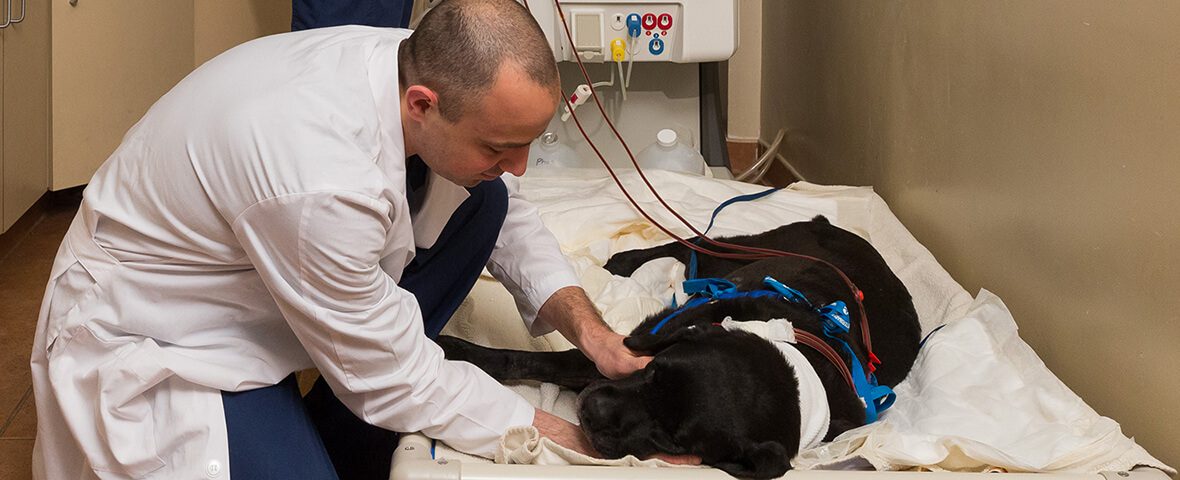Chronic Degenerative Valve Disease: Diagnosis, Treatment and Prognosis
Chronic degenerative valve disease (CVD) is a progressive degeneration of the valves in the heart (primarily the mitral valve).
This results in the thickening of the valve leaflets and a valvular leak that eventually causes heart enlargement and signs of heart failure.
In general, this is seen more frequently in small breed dogs, with up to 75% of small breed dogs showing evidence of CVD by 7 years of age. Certain breeds, such as the Cavalier King Charles spaniel and dachshund are predisposed, and may even present at a younger age.
Diagnosis
The first sign of CVD is typically a murmur heard by your veterinarian on a routine examination. The murmur is caused by the turbulent blood flow as blood leaks backwards across the affected valve. Once a murmur is heard, thoracic radiographs are taken to evaluate for heart enlargement and evidence of  congestive heart failure (fluid in the lungs or abdomen).
congestive heart failure (fluid in the lungs or abdomen).
The next step is referral to a cardiologist for an echocardiogram (ultrasound of the heart) to confirm diagnosis, evaluate for specific heart chamber enlargement, evaluate heart function and evaluate for other complications or sequelae of CVD. Other diagnostics, such as blood pressure or blood work may be recommended to further evaluate for other concurrent disease or factors that may complicate management of CVD.
Complications
The progression of the disease is variable in each dog and should be monitored on a regular basis, which in the asymptomatic stages means periodic thoracic radiographs to evaluate for progressive heart enlargement. Over time (which is often months to years), signs of heart failure may develop. These signs include cough, difficulty breathing, increased respiratory rate, weakness, lethargy, exercise intolerance and collapse. Less commonly, abdominal distension from fluid build-up in the abdomen may occur.
In some cases, arrhythmias as well as atrial rupture may develop, both of which may result in sudden worsening of symptoms or sudden death. Prolapsed valve leaflets may indicate a partial tear in the valve, and if a complete tear develops, this will result in sudden worsening and difficulty breathing.
Coughing due to compression of the major airways (mainstem bronchi) may result when heart enlargement is severe, without evidence of heart failure.
Pulmonary hypertension (PH), or high blood pressure in the lungs, may develop secondary to mitral valve disease. PH is best controlled by managing the underlying valvular disease. Medications can be added in if the PH increases in severity resulting in more pronounced clinical signs including exercise intolerance and collapse.
Treatment
In the asymptomatic stages of CVD, treatment is often not indicated unless there is severe heart enlargement.
Although diet changes and exercise restrictions are usually not indicated, avoiding very high sodium  diets and treats (bacon, pig ears, sausage, etc.) is always a good practice. Senior and kidney diets are lower in sodium.
diets and treats (bacon, pig ears, sausage, etc.) is always a good practice. Senior and kidney diets are lower in sodium.
As the disease progresses, the goal is to keep your pet out of heart failure without harming the kidneys and to help your pet maintain a good quality of life.
Medications used to treat heart failure include diuretics to help remove extra fluid from the body; a medication to help improve function of the heart (pimobendan); and other medications to help prevent fluid retention and fibrosis (scarring) of the heart muscle (such as angiotensin-converting enzyme inhibitors and spironolactone). Additional medications may be used to help control coughing or to control PH.
It is best to allow your pet to set his or her own pace. It is not uncommon for dogs with heart disease to be exercise intolerant, particularly in hot summer months.
Prognosis
CVD is a progressive disease. With careful monitoring, appropriate medical therapy can be implemented earlier in hopes of preventing rapid decline into severe heart failure. This way, we can limit visits to the hospital or emergency room, and keep your pet feeling as good as possible for as long as possible.
If your pet begins to show any signs of heart failure (cough, breathing difficulty, increased respiratory rate, abdominal distension, exercise intolerance or collapse), he or she should be evaluated sooner.
In general, the average life span after diagnosis of heart failure (fluid in the lungs or abdomen), with appropriate treatment, is 1-2 years. Frequent monitoring is important in maximizing treatment of heart failure.


